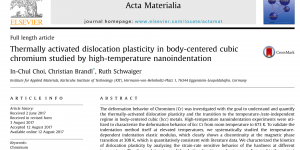 http://www.sciencedirect.com/science/article/pii/S1359645417306808 The deformation behavior of Chromium (Cr) was investigated with the goal to understand and quantify the thermally-activated dislocation plasticity and the transition to the temperature-/rate-independent regime in body-centered cubic (bcc) metals. High-temperature nanoindentation experiments were utilized to characterize the deformation behavior of bcc Cr from room temperature to 673 K. To validate the indentation method itself at elevated temperatures, we systematically […]
http://www.sciencedirect.com/science/article/pii/S1359645417306808 The deformation behavior of Chromium (Cr) was investigated with the goal to understand and quantify the thermally-activated dislocation plasticity and the transition to the temperature-/rate-independent regime in body-centered cubic (bcc) metals. High-temperature nanoindentation experiments were utilized to characterize the deformation behavior of bcc Cr from room temperature to 673 K. To validate the indentation method itself at elevated temperatures, we systematically […]
blogs.unimelb.edu.au/materials-mechanics-modelling/2017/10/22/thermally-activated-dislocation-plasticity-in-body-centered-cubic-chromium-studied-by-high-temperature-nanoindentation
 https://onlinelibrary.wiley.com/doi/10.1002/advs.201700159 Abstract: Some metal alloys subjected to irreversible plastic deformation can repair the inflicted damage and/or recover their original shape upon heating. The conventional shape memory effect in metallic alloys relies on collective, or “military” phase transformations. This work demonstrates a new and fundamentally different type of self-healing and shape memory in single crystalline faceted […]
https://onlinelibrary.wiley.com/doi/10.1002/advs.201700159 Abstract: Some metal alloys subjected to irreversible plastic deformation can repair the inflicted damage and/or recover their original shape upon heating. The conventional shape memory effect in metallic alloys relies on collective, or “military” phase transformations. This work demonstrates a new and fundamentally different type of self-healing and shape memory in single crystalline faceted […]
blogs.unimelb.edu.au/materials-mechanics-modelling/2017/10/22/self-healing-and-shape-memory-effects-in-gold-microparticles-through-the-defects-mediated-diffusion

